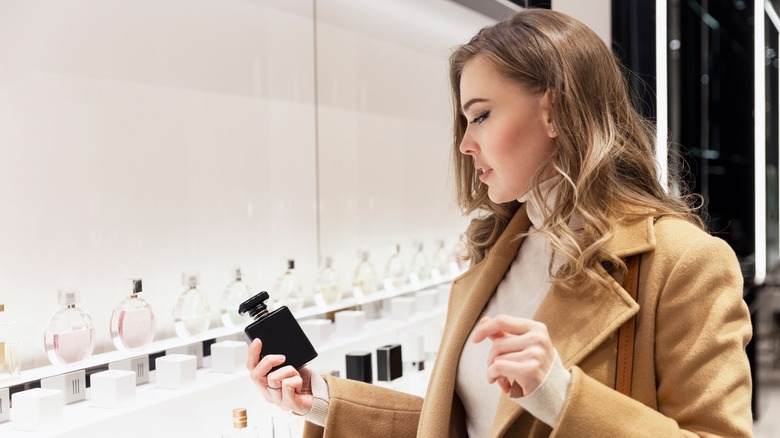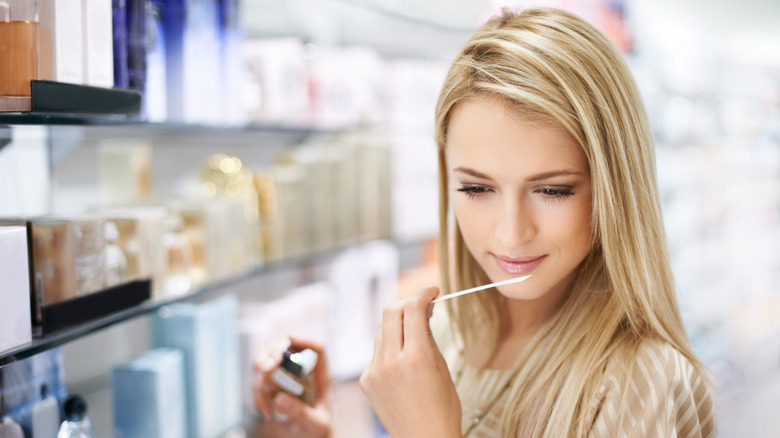What Does It Really Mean When A Perfume Is Non-Toxic?
The terminology used for cosmetics and beauty products can be confusing, especially since many, such as clean, cruelty-free, natural, non-toxic, and eco-friendly, are commonly used yet may not be fully understood by consumers. No one wants to spray toxic chemicals onto their body, but there are beauty products, such as perfumes, body sprays, and body mists, that contain ingredients that may qualify as being toxic to the skin or the environment. This is particularly important to be aware of since what we apply to our bodies is ultimately absorbed and has the potential to enter our bloodstream.
Throughout the history of the cosmetics industry, regulations have dictated what manufacturers can and cannot use in their products, but cosmetics are still largely unregulated and some manufacturers aren't as transparent as they probably should be.
So what does it really mean when a perfume claims to be non-toxic? Expressing yourself through a bottled scent should come with the reassurance that the product is free of toxins that may potentially cause harm to your body. Here's what you should know about perfumes labeled as non-toxic and the related terminology you're likely to hear when it comes to the bottled sprays you spritz on your skin.
There are thousands of ingredients used in perfumes
Knowing what's in your favorite perfume is the first step in making smart decisions about your fragrance purchases. The 2022 IRFA Transparency List looked at the global perfume manufacturing industry and compiled a comprehensive list of all ingredients used in perfumes and scented body sprays sold on the market. The list is broken down into two categories of products: fragrance ingredients identified as components intended for odor production or coverage of undesirable body odors and functional ingredients used to stabilize the longevity of a perfume.
In total, there were more than 3,000 different items identified as fragrance ingredients and 395 components listed in the functional ingredient category. The functional ingredients were found to be made up of preservatives, antioxidants, solvents, coloring, and diluents, all of which have been utilized to create products that can survive for long periods of time through the manufacturing, shipping, and purchasing processes. This is where a discerning eye is needed because these ingredients meant to give perfumes a long shelf life aren't always healthy for skin absorption.
When you are searching for the perfect scent, you should definitely read the ingredients label on the back of the bottle. However, you should go a step further than that and research the company that manufactures the perfume also, because they are not required to disclose all ingredients.
Non-toxic perfumes can have undisclosed ingredients
According to Kinder Beauty, since perfume manufacturers aren't mandated to disclose comprehensive lists of ingredients used to create their products, there's a risk of unknowingly exposing your body to toxic ingredients or even jeopardizing your health with a potential allergic reaction to an undisclosed ingredient. Furthermore, some chemicals used in perfumes and body sprays can provoke hormonal disruptions when absorbed into the skin.
An unfortunate fact is that manufacturers are able to include non-FDA-approved ingredients in perfumes, colognes, and body sprays. They are also not required to disclose them, with some perfumes on the market containing more than 40 undisclosed ingredients, per Kinder Beauty. This practice is extremely dangerous, thus making the search for niche brands, companies, and products that are openly transparent and honest about their ingredients even more important.
Understanding how manufacturers reveal or don't reveal their ingredients is imperative knowledge. Non-toxic doesn't automatically mean perfumes are made of only 100% natural ingredients. Many perfumes labeled as being non-toxic in fact contain artificial ingredients, and some people who are sensitive to these ingredients may experience side effects such as headaches from inhaling them. So, whether you're someone with an olfactory sensitivity or you simply want a perfume free of potentially harmful, artificial ingredients, then you'll want to search for perfumes labeled both non-toxic and 100% natural.
Clean and non-toxic perfume transparency
With a growing consumer desire for environmentally friendly and healthy products, many producers of perfumes and cosmetics have become increasingly transparent about the ways in which they manufacture their products and the ingredients they use. There is reassurance in this rising trend of companies promoting their perfumes and body sprays as being non-toxic.
According to Organic Beauty Lover (OBL), confusion can quickly arise when trying to understand the terminology of clean, non-toxic, and natural perfumes. There are some key differences between the terms, however. Perfumes labeled as being clean may contain synthetic ingredients that have been found to be non-toxic to the skin, while perfumes labeled as being natural are typically void of synthetic ingredients altogether. Again, the exact definition of each term comes down to the individual company, but over the past decade, the terminology has become more streamlined as socially and environmentally conscious products have become more in demand.
Seeking out niche brands or companies founded on mission statements specifying dedication to clean, non-toxic, or natural products are more likely to sell genuinely non-toxic perfumes. Additionally, searching for vegan products is another way to weed out toxic ingredients.
How to find truly conscious perfumes
The reality of non-toxic perfumes is that the terminology used to describe them is often vague and misleading to buyers, sometimes intentionally so. With growing demands for conscious products, bunnywashing in the beauty industry means terms like non-toxic, clean, eco-friendly, and cruelty-free are being used to make products more appealing to buyers, even when the products don't actually fulfill the perceived standards for the labels.
Given existing loopholes for manufacturers to falsely promote products through the omission of undisclosed ingredients, the definition of what makes a perfume non-toxic is much more nuanced than simply the ingredients in the bottle. A true non-toxic perfume isn't just a bottled scent free from harmful ingredients, it's also a product that's manufactured and sold by a company with ethical transparency and honesty about the ingredients they use. If you want a non-toxic perfume, you need to find brands you feel you can trust and whose values align with yours.
The fact that consumers can't be confident in the ingredients listed on perfume bottles is just the tip of the iceberg when it comes to toxic practices hidden within the beauty and cosmetic industries. Luckily, there are brands out there that are staunchly dedicated to the mission of creating natural, organic, and safe perfumes. It just takes some research to find them.




